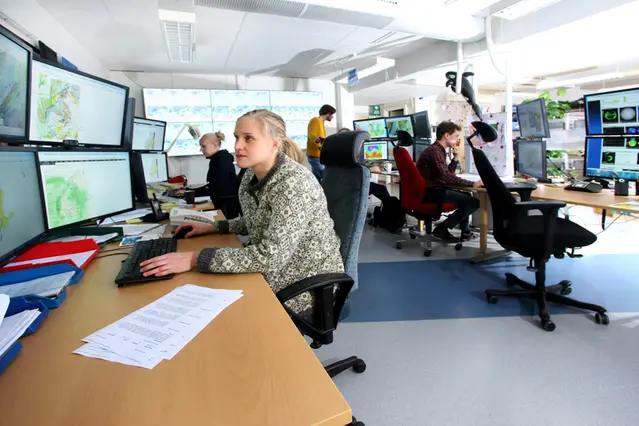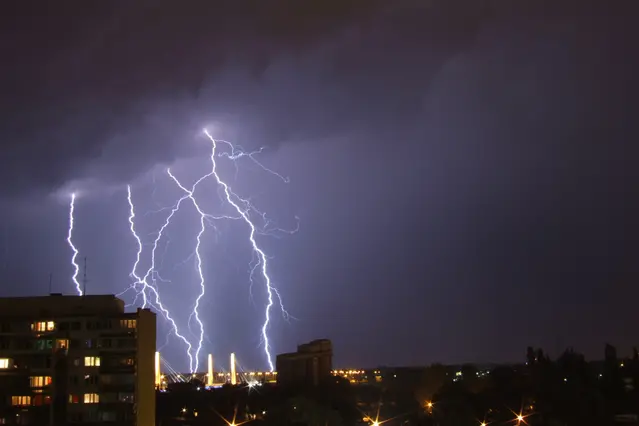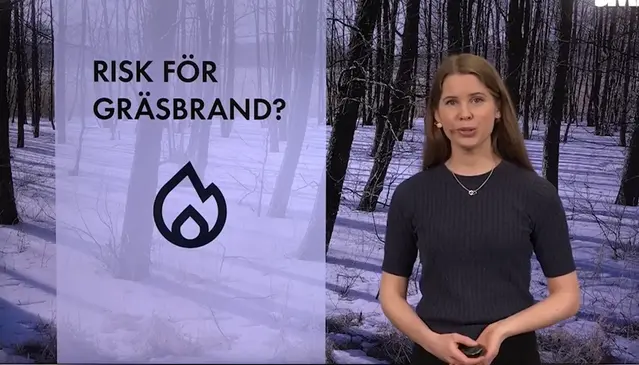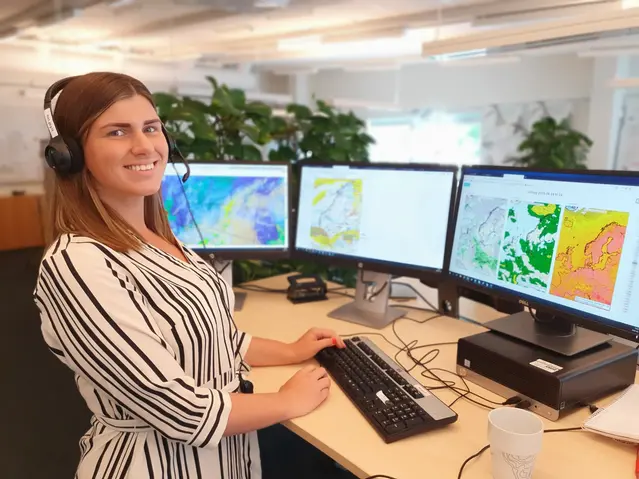What does a meteorologist do at SMHI?
Meteorologists are often associated with presenting weather on TV or radio, but a meteorologist can work on a range of different tasks.
Many meteorologists work at SMHI, and only a small portion of them create weather forecasts and issue warnings for severe weather. There are many who work as climate researchers, while others focus on air quality and analyse how pollutants spread in the atmosphere. Some specialise in further developing the forecasting models that underpin weather predictions, and SMHI also employs meteorologists who review historical data going back to the 1700s and the statistics based on weather observations.
Below, you can explore some of the different roles that meteorologists have at SMHI.
Forecast meteorologists create and communicate forecasts
Working as a forecast meteorologist can involve a range of activities, from advising helicopter pilots conducting rescue operations in the mountains to discussing the weather on local radio. What all forecast meteorologists have in common is that they produce weather forecasts and communicate these to various customers or stakeholders in society.
At SMHI, there are several departments with forecast meteorologists who specialise in different areas of expertise.
In our core operations, meteorologists create weather forecasts based on various weather models. They also issue weather warnings in cases of severe weather such as heavy rain or storms. These forecasts are communicated through SMHI’s website, weather app, radio, and social media.
Our aviation meteorologists issue forecasts and warnings for air traffic in Sweden. They have daily contact with pilots and air traffic controllers across the country.
We also have a group of meteorologists who develop tailored forecasts and warnings for different customer groups such as farmers, the construction industry, asphalt layers, and snow removal services. Additionally, they produce forecasts for the energy sector and ferry traffic in Sweden.

Observations show the weather here and now
For our forecast meteorologists to create a weather forecast, they first need to know the current weather conditions. Some meteorologists work specifically on gathering these weather observations. Observations are also used for a variety of other purposes, such as studying our climate, air quality, verifying forecasts, and much more.
These meteorologists focus on reviewing and ensuring that measurements and observations are as accurate as possible. SMHI operates around 640 weather stations from north to south that measure and collect meteorological observations such as temperature, wind, precipitation, and air pressure. Many measurements are taken automatically, but most of the precipitation measurements are manually recorded by individuals who have their own small weather stations on their property.
Meteorologists at SMHI are responsible for the placement of these weather stations, as the location is crucial for obtaining observations that are representative of larger areas. For instance, stations should not be placed near large buildings or dense forests, as this can affect everything from wind to temperature observations.
Meteorologists periodically visit our observers to conduct training, cheque the measuring equipment, and ensure that the observation site meets the required standards.
All data, meaning all observations, are reviewed by meteorologists to identify any potential measurement errors.
These observations are then used as input for weather forecasts, to map and study Sweden's climate, and to verify that the weather actually matched the forecasts provided.

How to become a meteorologist
Are you interested in weather, climate, and climate change? Do you want to understand how these issues affect our lives today and in the long term? Then a career in meteorology might be for you!
Statistics reflecting past weather and climate
At SMHI, meteorologists also compile and refine information and statistics about weather and climate. This is crucial for providing various societal actors with reliable decision-making support.
Meteorologists monitor the current weather situation and summarise it monthly, seasonally, and annually in texts, tables, and visualisations that are regularly published on SMHI's website.
They cheque the quality and analyse historical meteorological observation data to describe how different parameters, such as temperature and precipitation, vary over time. This enables SMHI to quantify both historical and current climate changes.
Meteorologists also respond to questions about meteorology and climate from the public via email and phone. They participate in investigations requiring meteorological expertise and respond to enquiries from departments and other authorities.

Consultants provide expert services for industries, companies, and cities
At SMHI's consulting division, meteorologists handle both small and large projects for businesses across various industries, municipalities, government agencies, and county administrative boards. These projects may involve expert input on climate, meteorology, or air quality.
Some meteorologists work on dispersion calculations for air pollutants. This could involve industries needing to assess the spread of their emissions or municipalities seeking to understand pollution levels on a specific traffic-heavy street. Other projects focus on compiling weather statistics for companies to plan construction projects based on optimal weather conditions.
A common type of project is calculating the wind climate in urban environments when planning new high-rise buildings, neighbourhoods, or districts. Using flow models run on powerful supercomputers, wind patterns are simulated to identify areas that might be particularly windy. This allows clients, who are designing environments around buildings, to choose locations for features like playgrounds or outdoor seating areas where the wind conditions are more favourable.

Many research and develop meteorology
At SMHI, many meteorologists work in research and development with the aim of improving the ability to describe and predict atmospheric conditions. This includes enhancing weather forecasts, studying emissions and chemical processes in the atmosphere that affect air quality, and researching the complex issues related to climate change and its future impacts.
There are four main areas of focus for meteorological research at SMHI:
- Numerical Weather Prediction
- Remote Sensing with Radar and Satellites
- Air Quality
- Climate
Numerical weather forecasts are produced using supercomputers
At SMHI, meteorologists work on developing and improving the fundamental forecasting models used to predict the weather. These meteorologists are often researchers with a focus on dynamic meteorology and numerical weather prediction. The work requires not only a deep understanding of atmospheric processes but also extensive knowledge in computer programming and handling large, complex software running on powerful supercomputers.
Numerical weather models are the basis for the weather forecasts presented by SMHI. These are mathematical models that use physical laws to calculate how the weather will evolve. The models start with an initial state—i.e., the current weather conditions—and then calculate how these conditions will change over time. The better the description we have of the current weather situation, the more accurate the weather forecasts will be.
Meteorologists also work on developing improved methods for verifying forecasts, which involves checking whether the forecasts were accurate or not.
A significant portion of this work occurs through various international collaborations, particularly within Nordic and European networks. Countries cooperate because the work and computational power required are too extensive for any single country to handle alone.
Remote sensing with radar and satellites
SMHI is a major user of remote sensing data, which involves observations made from a distance without direct physical contact with the observed phenomena. Various instruments are used, such as radar and satellites.
The applications of these observations are vast and used throughout SMHI, not only by meteorologists but also by our hydrologists and oceanographers who study water on land and in the oceans. Researchers are continuously working to improve and develop methods to extract as much information from these observations as possible, and to use this data for various types of analyses and to enhance weather forecasts.
With the help of radar, meteorologists can see where precipitation is occurring, its intensity, and whether it is rain, snow, or hail.
Satellites orbiting Earth provide a wealth of information, such as cloud cover, sea ice extent, and algal blooms in the oceans.
Information from radar and satellites is crucial for improving the initial conditions—the current weather situation used by weather models to predict future weather. These observations can also be used retrospectively to verify the accuracy of our weather forecasts.
Remote sensing can also be applied in climate and environmental monitoring. For example, it can be used to study changes in cloud cover and temperature over extended periods, and to detect and analyse air pollutants and greenhouse gases.
Air quality – a prerequisite for our health!
Clean air is essential for human health and for protecting animals, plants, and cultural heritage from damage. Increasing our understanding of the physical and chemical processes that affect the spread of air pollutants is crucial for grasping current and future air quality.
Meteorologists within SMHI's air quality research work on a wide range of issues related to air quality, including those caused by human-made emissions as well as natural substances. The questions they address involve various consequences, such as health and economic impacts, climate change, acidification, and eutrophication.
Air quality research at SMHI primarily focuses on modelling and data analysis of atmospheric transport, emissions, chemical and physical transformation, and deposition (fallout) of air pollutants. SMHI meteorologists develop numerical models and perform calculations on various geographic scales, ranging from local scales, such as individual streets in cities, to studies covering entire continents!
We conduct climate research for Sweden and the world
At SMHI, a growing number of meteorologists work to describe and understand both Sweden's and the Earth's climate. Using a vast amount of observational data and various computer-based modelling tools, they aim to gain insights into how the climate has historically changed and how it might change in the future. This work is of central importance to society, given the increasingly alarming climate changes that we are frequently reminded of.
We often work in international collaborations because climate is a global phenomenon that affects us all. A key part of our work involves contributing to the activities of the IPCC (Intergovernmental Panel on Climate Change). The IPCC is a UN body tasked with assessing the science related to climate change. This includes contributing to the regularly recurring scientific evaluations of the state of the Earth's climate. SMHI serves as the IPCC's contact point in Sweden.
Researchers at SMHI also act as expert bodies on climate issues, providing knowledge support to the parliament, government, and society at large.
